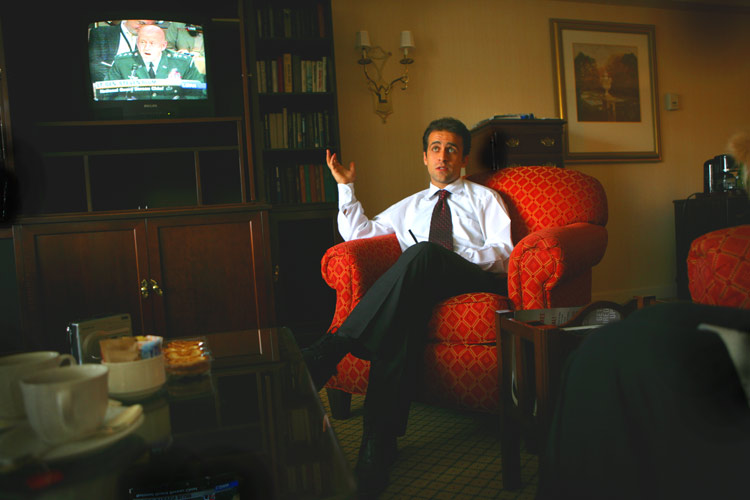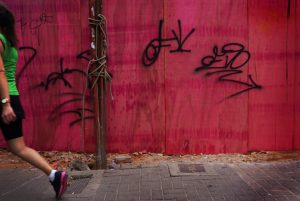
Sitting in a smart DC hotel Amir Abbas Fakhrvar recalls terrible tales of his incarceration in Iranian jails. He gives details of the sensory depravation and other torture he faced over the last 10 years. His crime? To support full open democracy and liberty and then to publish his dissenting views about the totalitarian Islamic state. It struck me as a suitable juxtaposition to include the images of C-span TV flickering silently away on his hotel room TV. The sound is turned down but I know General Steven Blum National Guard Chief is defending the deployment of National Guard soldiers to the US/Mexican border to his oversight committee of lawmakers at the House of Representatives. The Lawmakers are quizzing him on the Presidents decision to send the National Guardsmen to the border and the Guard’s ability to respond. Even as a British guy who has always lived in a free society I am sometimes amazed at the real-time political oversight and accountability that is built into the US political system and is just available for all to see. It is undeniably one of the most open, most free countries in the world. The contrast to the fear, repression and ignorance fostered by current Islamic fundamentalist regime in Iran is total.
[ 6 ] comments
- This is a wonderful stunning shot. There is a great atmosphere in it. Great great great!
Frank @ May 22, 2006, 3:14 pm
- very nice composition, alot stuff going on, i’m immediately drawn to the man in the chair, but quickly scan the rest of the room for the rest of the story
fakeplastic @ May 23, 2006, 12:17 am
- Interesting composition!
tetsu @ July 3, 2006, 11:03 pm
- Fakhravar is a fraud, and no amount of flattering photography can alter that fact. Please do some research before glorifying people like Fakhravar and stereotyping Iran and Iranians. Have a look at this parody, it aptly captures how most serious Iranian activists and observors feel about Fakhravar. http://benevis-dige.blogspot.com/2006/10/fakhravar-mastercon.html
Niki @ October 16, 2006, 10:26 pm
- Niki…..er……well Thanks for your link making fun of a man who has spent years in Iran’s jails……er….. I am guessing you have the advantage of living in America? I do not know much about the point scoring you are attempting? People could look at that and make of it what they will, but for anyone interested to know more about the fundamentalist leaders of Iran I suggest http://www.tnr.com/doc.mhtml?i=20060424&s=kuntzel042406 (or that article from the above link is now copied below) Cheers Jez
jez @ October 17, 2006, 10:16 am
- Here below is the informative article I was recomending as it did not always appear on the link I gave above: Cheers Jez : Ahmadinejad’s demons Matthias Kuntzel The New Republic 25 April 2006 During the Iran-Iraq War, the Ayatollah Khomeini imported 500,000 small plastic keys from Taiwan. The trinkets were meant to be inspirational. After Iraq invaded in September, 1980, it had quickly become clear that Iran’s forces were no match for Saddam Hussein’s professional, well-armed military. To compensate for their disadvantage, Khomeini sent Iranian children, some as young as 12 years old, to the front lines. There, they marched in formation across minefields toward the enemy, clearing a path with their bodies. Before every mission, one of the Taiwanese keys would be hung around each child’s neck. It was supposed to open the gates to paradise for them. These children who marched to their deaths were part of the Basiji, a mass movement created by Khomeini in 1979. This volunteer militia went enthusiastically, and by the thousands, to their own destruction. According to one veteran of the Iran-Iraq War, “It was sometimes like a race. Even without the commander’s orders, everyone wanted to be first.” The sacrifice of the Basiji was ghastly. And yet, today, it is a source of growing pride. Since the end of hostilities against Iraq in 1988, the Basiji have grown both in numbers and influence. They have been deployed, above all, as a vice squad to enforce religious law in Iran, and their elite “special units” have been used as shock troops against anti-government forces. Last year, they formed the potent core of the political base that propelled Mahmoud Ahmadinejad — a man who reportedly served as a Basij instructor during the Iran-Iraq War — to the presidency. Ahmadinejad revels in his alliance with the Basiji. He regularly appears in public wearing a black-and-white Basij scarf, and, in his speeches, he routinely praises “Basij power.” Ahmadinejad’s ascendance on the shoulders of the Basiji means that the Iranian Revolution, launched almost three decades ago, has entered a new and disturbing phase. A younger generation of Iranians, whose worldviews were forged in the atrocities of the Iran-Iraq War, have come to power, wielding a more fervently ideological approach to politics than their predecessors. Most Basiji came from the countryside and were often illiterate. When their training was done, each Basiji received a blood-red headband that designated him a volunteer for martyrdom. The chief combat tactic employed by the Basiji was the human wave attack, whereby barely armed children and teenagers would move continuously toward the enemy in perfectly straight rows. It did not matter whether they fell to enemy fire or detonated the mines with their bodies. Once a path to the Iraqi forces had been opened up, Iranian commanders would send in their more valuable and skilled Revolutionary Guard troops. “They come toward our positions in huge hordes with their fists swinging,” one Iraqi officer complained in the summer of 1982. “You can shoot down the first wave and then the second. But at some point the corpses are piling up in front of you, and all you want to do is scream and throw away your weapon. Those are human beings, after all!” Why did the Basiji volunteer for such duty? Most were recruited by members of the Revolutionary Guards, which commanded the Basiji. These “special educators” would visit schools and handpick their martyrs from the paramilitary exercises in which all Iranian youth were required to participate. Propaganda films — like the 1986 TV film A Contribution to the War — praised this alliance between students and the regime, and undermined those parents who tried to save their children’s lives. In 1982, the German weekly Der Spiegel documented the story of a 12-year-old boy named Hossein, who enlisted with the Basiji despite having polio: “One day, some unknown imams turned up in the village. They called the whole population to the plaza in front of the police station, and they announced that they came with good news: The Islamic Army of Iran had been chosen to liberate the holy city Al-Quds — Jerusalem — from the infidels …. The local mullah had decided that every family with children would have to furnish one soldier of God. Because Hossein was the most easily expendable for his family, and because, in light of his illness, he could in any case not expect much happiness in this life, he was chosen by his father to represent the family in the struggle.” (Of the 20 children that went into battle with Hossein, only he and two others survived.) At the beginning of the war, Iran’s ruling mullahs did not send human beings into the minefields, but rather animals: donkeys, horses and dogs. But the tactic proved useless: “After a few donkeys had been blown up, the rest ran off in terror,” Mostafa Arki reports in his book Eight Years of War in the Middle East. The donkeys reacted normally — fear of death is natural. The Basiji, on the other hand, marched fearlessly to their deaths. The curious slogans that they chanted while entering the battlefields are of note: “Against the Yazid of our time!”; “Hussein’s caravan is moving on!”; “A new Karbala awaits us!” Yazid, Hussein, Karbala — these are all references to the founding myth of Shia Islam. In the late seventh century, Islam was split between those loyal to the Caliph Yazid — the predecessors of Sunni Islam — and the founders of Shia Islam, who thought that the Imam Hussein, grandson of the Prophet Muhammad, should govern the Muslims. In 680, Hussein led an uprising against the “illegitimate” caliph, but he was betrayed. On the plain of Karbala, Yazid’s forces attacked Hussein and his entourage and killed them. Hussein’s corpse bore the marks of 33 lance punctures and 34 blows of the sword. His head was cut off and his body was trampled by horses. Ever since, the martyrdom of Hussein has formed the core of Shia theology, and the Ashura Festival that commemorates his death is Shiism’s holiest day. On that day, men beat themselves with their fists or flagellate themselves with iron chains to approximate Hussein’s sufferings. At times throughout the centuries, the ritual has grown obscenely violent. In his study Crowds and Power, Elias Canetti recounts a first-hand report of the Ashura Festival as it occurred in mid-19th-century Tehran: “500,000 people, in the grip of delirium, cover their heads with ashes and beat their foreheads against the ground. They want to subject themselves voluntarily to torments: to commit suicide en masse, to mutilate themselves with refinement … Hundreds of men in white shirts come by, their faces ecstatically raised toward the sky. Of these, several will be dead this evening.” During the Iran-Iraq War, Khomeini took this inward-directed fervour and channelled it toward the external enemy. He transformed the passive lamentation into active protest. He made the Battle of Karbala the prototype of any fight against tyranny. On the one hand, the scoundrel Yazid, now in the form of Saddam Hussein; on the other, the Prophet’s grandson, Hussein, for whose suffering the time of Shia revenge had finally come. The power of this story was reinforced by a theological twist that Khomeini gave it. According to Khomeini, life is worthless and death is the beginning of genuine existence. This latter world is accessible to martyrs: Their death is no death, but merely the transition from this world to the world beyond, where they will live on eternally and in splendour. Military victories are secondary, Khomeini explained in September, 1980. The Basiji must “understand that he is a ‘soldier of God’ for whom it is not so much the outcome of the conflict as the mere participation in it that provides fulfilment and gratification.” For those whose courage still waned in the face of death, the regime put on a show. A mysterious horseman on a magnificent steed would suddenly appear on the front lines. His face — covered in phosphorus — would shine. His costume was that of a medieval prince. A child soldier, Reza Behrouzi, whose story was documented in 1985 by the French writer Freidoune Sehabjam, reported that the soldiers reacted with a mixture of panic and rapture: “Everyone wanted to run toward the horseman. But he drove them away. ‘Don’t come to me!’ he shouted, ‘Charge into battle against the infidels! … Revenge the death of our Imam Hussein and strike down the progeny of Yazid!’ ” The mysterious apparition who was able to trigger such emotions is the “hidden imam,” a mythical figure who influences Ahmadinejad to this day. The Shia call all the male descendants of the Prophet Muhammad “imams” and ascribe to them a quasi-divine status. Hussein, who was killed at Karbala by Yazid, was the third Imam. His son and grandson were the fourth and fifth. At the end of this line, there is the “Twelfth Imam,” who is named Muhammad. Some call him the Mahdi (the “divinely guided one”). He was born in 869, the only son of the eleventh Imam. In 874, he disappeared without a trace, thereby bringing Muhammad’s lineage to a close. In Shia mythology, however, the Twelfth Imam survived. The Shia believe that he merely withdrew from public view when he was five and that he will emerge from his “occultation” in order to liberate the world from evil. In Among the Believers: An Islamic Journey, V. S. Naipaul described seeing posters in post-Revolutionary Tehran bearing motifs similar to those of Maoist China: crowds, for instance, with rifles and machine guns raised in the air as if in greeting. The posters always bore the same phrase: “Twelfth imam, we are waiting for you.” According to Shia tradition, legitimate Islamic rule can only be established following the twelfth imam’s reappearance. Khomeini, however, had no intention of waiting. He vested the myth with an entirely new sense: The Twelfth Imam will emerge only when the believers have vanquished evil. To speed up the Mahdi’s return, Muslims had to shake off their torpor and fight. It was this culture that nurtured Mahmoud Ahmadinejad’s worldview. Born outside Tehran in 1956, the son of blacksmith, he trained as a civil engineer and, during the Iran-Iraq War, he joined the Revolutionary Guards. His biography remains strangely elliptical. Did he play a role in the 1979 takeover of the U.S. Embassy, as some charge? What exactly did he do during the war? We have no definite answers. We do know that after the war’s end, he served as the governor of Ardebil Province and as an organizer of Ansar-e Hezbollah, a radical gang of violent Islamic vigilantes. After becoming mayor of Tehran in April, 2003, Ahmadinejad used his position to build up a strong network of radical Islamic fundamentalists. It was in that role that he won his reputation — and popularity — as a hardliner devoted to rolling back the liberal reforms of then-President Muhammad Khatami. Ahmadinejad positioned himself as the leader of a “second revolution” to eradicate corruption and Western influences from Iranian society. And the Basiji, whose numbers had grown dramatically since the end of the Iran-Iraq War, embraced him. Recruited from the more conservative and impoverished parts of the population, the Basiji fall under the direction of — and swear absolute loyalty to — the Supreme Leader Ali Khamenei, Khomeini’s successor. During Ahmadinejad’s run for the presidency in 2005, the millions of Basiji — in every Iranian town, neighbourhood, and mosque — became his unofficial campaign workers. As Basij ideology and influence enjoy a renaissance under Ahmadinejad, the movement’s belief in the virtues of violent self-sacrifice remains intact. Since 2004, the mobilization of Iranians for suicide brigades has intensified, with recruits being trained for foreign missions. Thus, a special military unit has been created bearing the name “Commando of Voluntary Martyrs.” According to its own statistics, this force has so far recruited some 52,000 Iranians to the suicidal cause. It aims to form a “martyrdom unit” in every Iranian province. The Basiji’s cult of self-destruction would be chilling in any country. In the context of the Iranian nuclear program, however, its obsession with martyrdom amounts to a lit fuse. Nowadays, Basiji are sent not into the desert, but rather into the laboratory. Basij students are encouraged to enroll in technical and scientific disciplines. According to a spokesperson for the Revolutionary Guard, the aim is to use the “technical factor” in order to augment “national security.” What exactly does that mean? Consider that in December, 2001, former Iranian President Hashemi Rafsanjani explained that “the use of even one nuclear bomb inside Israel will destroy everything.” On the other hand, if Israel responded with its own nuclear weapons, it “will only harm the Islamic world. It is not irrational to contemplate such an eventuality.” Rafsanjani thus spelled out a macabre cost-benefit analysis. It might not be possible to destroy Israel without suffering retaliation. But, for Islam, the level of damage Israel could inflict is bearable — only 100,000 or so additional martyrs for Islam. And Rafsanjani is a member of the moderate, pragmatic wing of the Iranian Revolution; he believes that any conflict ought to have a “worthwhile” outcome. Ahmadinejad, by contrast, is predisposed toward apocalyptic thinking. In one of his first TV interviews after being elected president, he enthused: “Is there an art that is more beautiful, more divine, more eternal than the art of the martyr’s death?” In September, 2005, he concluded his first speech before the United Nations by imploring God to bring about the return of the Twelfth Imam. A politics pursued in alliance with a supernatural force is necessarily unpredictable. Why should an Iranian president engage in pragmatic politics when his assumption is that, in three or four years, the saviour will appear? If the messiah is coming, why compromise? That is why, up to now, Ahmadinejad has pursued confrontational policies with evident pleasure. The history of the Basiji shows that we must expect monstrosities from the current Iranian regime. Already, what began in the early 1980s with the clearing of minefields by human detonators has spread throughout the Middle East, as suicide bombing has become the terrorist tactic of choice. And the Basiji who once upon a time wandered the desert armed only with a walking stick is today working as a chemist in a uranium enrichment facility. – Matthias Kuntzel is a political scientist in Hamburg, Germany and author of Djihad und Judenhass (Jihad and Jew-Hatred).
jez @ October 17, 2006, 10:41 am



